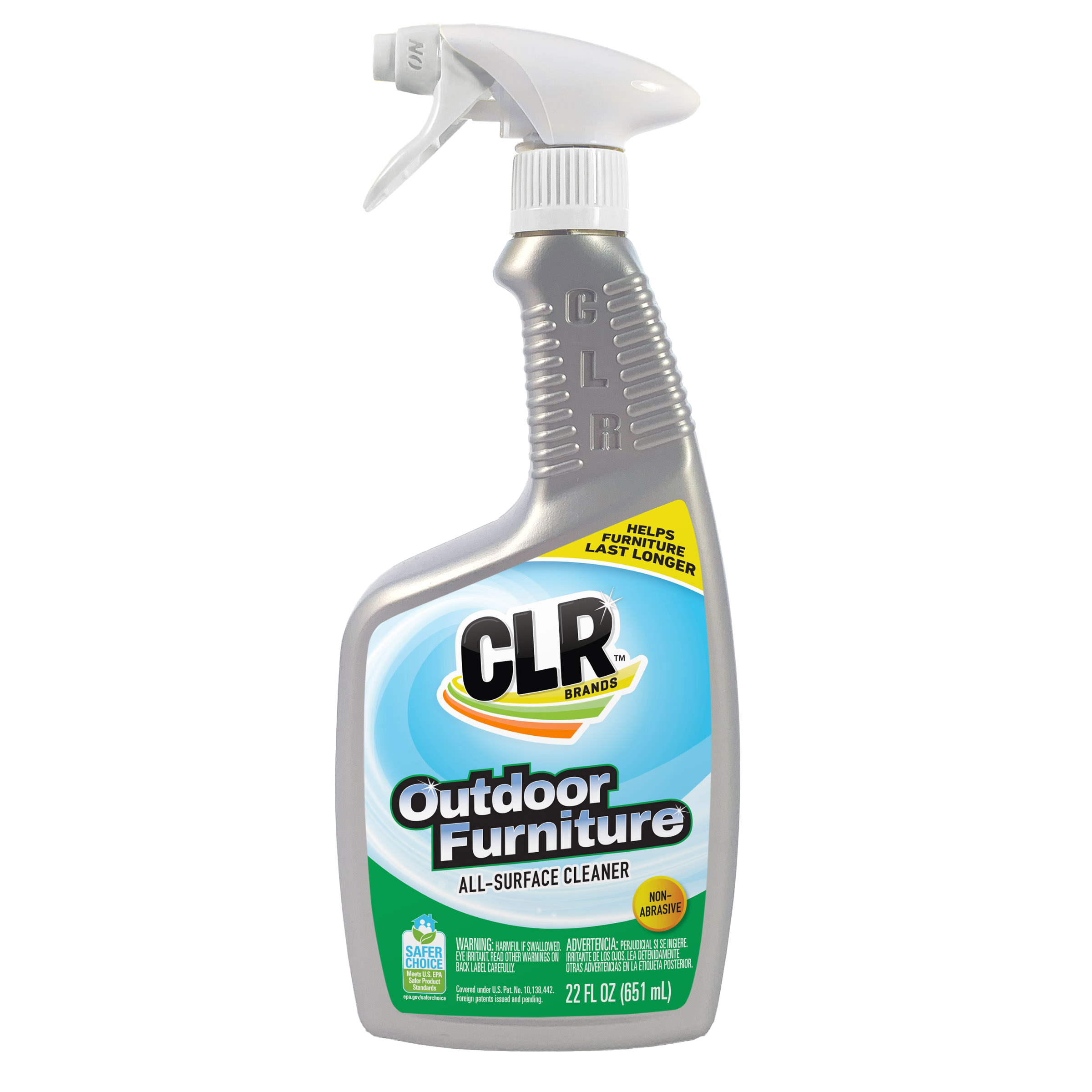
Outdoor Furniture Cleaner
- Specially formulated to remove outdoor dirt and grime quickly and easily from resin, plastic, rattan, wicker, wood, wrought iron, vinyl, PVC and canvas.
- Safe to use on all outdoor furniture including cushions, awnings, children’s play equipment and more.
- Non-abrasive formula.
- Formula will not harm grass.
Look for Outdoor Furniture Cleaner in this size
- 22 oz. spray
- 26 oz. spray
For use on these surfaces
- Canvas
- Fabric
- Plastic/Resin
- PVC
- Rattan
- Wicker
- Wood
- Wrought Iron
More information
How to use this product
- Wear household gloves.
- Spray on generously.
- Let soak to allow dirt to loosen, then wipe or brush.
- For woven surfaces: cushions and fabrics use a soft bristled brush.
- For smooth surfaces: use a brush, cloth or sponge.
- Rinse thoroughly with cool clean water.
Product ingredients

| Water | Dilutent: CAS #7732-18-5 |
|
|
| Dilutent: CAS #7732-18-5. Reverse Osmosis (RO) is a water treatment process that removes contaminants from water by passing the water through a membrane, (filter), where contaminants are filtered out yielding more pure quality water. | |||
| Caprylyl/Capryl Glucoside | Surfactant: CAS #68515-73-1. |
|
|
| Surfactant: CAS #68515-73-1. A mild, solubilising non-ionic surfactant which modifies the surface tension of water, to aid in even spreading and to allow mixing with oil and dirt so that they can be rinsed away. It is obtained from renewable raw materials: fatty alcohols and vegetable sugars. As part of the EPA Safer Choice Program, it has been evaluated and determined to be safer than traditional chemical ingredients. | |||
| Sodium Gluconate | Chelating Agent/Processing Aid: CAS #527-07-1. |
|
|
| Chelating Agent/Processing Aid: CAS #527-07-1. A salt of gluconic acid. It acts as a chelating agent that makes metals more soluble in water and is a processing aid commonly used in household cleaning products. It is often found in bar soap, sunscreen, shampoo, toothpaste and a variety of other products as well. As part of the EPA Safer Choice Program, it has been evaluated and determined to be safer than traditional chemical ingredients. | |||
| Sodium Lactate | Moistening Agent: CAS #867-56-1. |
|
|
| Moistenting Agent: CAS #867-56-1. Derived from the natural fermentation of sugar. Sodium lactate is the sodium salt of lactic acid. It is sometimes used in liquid soap products, as it is an effective substance used to keep things moist. As part of the EPA Safer Choice Program, it has been evaluated and determined to be safer than traditional chemical ingredients. | |||
| Sodium Citrate | pH Adjuster, Cleaning Agent and Preserve: CAS #6132-04-3. |
|
|
| pH Adjuster, Cleaning Agent and Preserve: CAS #6132-04-3. Sodium citrate is a salt of citric acid. Citric acid is a weak acid that is widely found in both plants and animals. It is a natural ingredient that is common in citrus fruits. It is often used as a pH adjuster, water softener, cleaning agent and preservative.As part of the EPA Safer Choice Program, it has been evaluated and determined to be safer than traditional chemical ingredients. | |||
| Potassium Bicarbonate | Cleaning Agent: CAS #298-14-6. |
|
|
| Cleaning Agent: CAS #298-16-6. Potassium Bicarbonate is an effective inorganic salt, that can be used as a replacement for sodium bicarbonate (baking soda). As part of the EPA Safer Choice Program, it has been evaluated and determined to be safer than traditional chemical ingredients. | |||
| Gluconic Acid | Chelating Agent: CAS #526-95-4. |
|
|
| Chelating Agent: CAS #526-95-4. This ingredient is an acid formed from the sugar glucose, which naturally occurs in fruit, honey and wine. It is a chelating agent; a compound that makes metals more soluble in water. As part of the EPA Safer Choice Program, it has been evaluated and determined to be safer than traditional chemical ingredients. | |||
FAQs
How do I use Outdoor Furniture Cleaner?
When using Outdoor Furniture Cleaner always wear household rubber gloves and test on a hidden area of the surface before beginning to clean. When cleaning, apply the solution to a clean damp cloth, sponge, brush or directly to the surface to be cleaned, allow the cleaner time to work and then rinse with clean, cold water from your hose. For woven surfaces, cushions and fabric, use a soft-bristled brush while for smooth surfaces use a soft-bristled brush or a clean damp cloth. After cleaning, if the stain persists, repeat the process. Do not use Outdoor Furniture Cleaner with other cleaners or bleach. Never reuse the bottle when it is empty.
What can I use Outdoor Furniture Cleaner on?
It can be used on resin, plastic, rattan, wicker, wood, wrought iron, vinyl, PVC and canvas.
Can Outdoor Furniture Cleaner be used on colored resin?
Yes. Resin is a type of plastic and Outdoor Furniture Cleaner is safe on white and colored resin including resin furniture and resin sporting or play equipment.
